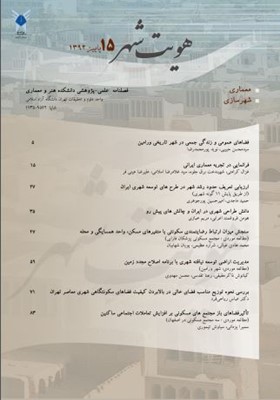فضاهای عمومی و زندگی جمعی در شهر تاریخی ورامین
محورهای موضوعی : معماریسید محسن حبیبی 1 , نوید پورمحمدرضا 2 *
1 - استاد دانشکده شهرسازی، پردیس هنرهای زیبا، دانشگاه تهران، تهران، ایران
2 - دانش¬آموخته¬ی کارشناسی ارشد شهرسازی، پردیس هنرهای زیبا، دانشگاه تهران، تهران، ایران
کلید واژه: فضای عمومی, فضای شهری, فضای سبز, فضای مذهبی, فضای بالقوه,
چکیده مقاله :
هدف اصلی نوشتارِ حاضر بررسی و تحلیل فضاهای عمومی و زندگی جمعی در شهر تاریخی ورامین است.با عطف به پژوهش های میدانی، روایتی توصیفی-تحلیلی از محتوا و کالبد فضاها و مکان های ورامین در قالب سه گونه ی اصلی (فضاهای شهری، فضاهای مذهبی، فضاهای سبز) و یک گونه ی فرعی (فضاهای غیررسمی و بالقوه) ارائه شده است. در انتها نیز از طریق مقابله ی یافته های میدانی با مبانی نظری پژوهش، ویژگی ها و مشخصه های فضاهای عمومی شهر ورامین بر مبنای معیارهای سه گانه کالبدی، عملکردی و اجتماعی تعریف و تبیین می گردند. بخش مرکزی و قدیمی ورامین را می توان مهمترین فضای عمومی شهر در نظر گرفت؛ این فضا بازتاب سویههای متعدد و متکثر مفهوم فضای عمومی است، نظیر: خرید، استراحت، تفریح، جامعهپذیری، خودجوشی و خودانگیختگی اجتماعی و سایر فضاها و مکانها، هم چون میدان عمروآباد، پارک خانواده، و امامزداه حسینرضا، هریک، بنابر ماهیت و ویژگیهای خویش، بیشوکم نمایانگر گوشهای از ابعاد و جلوههای متکثرِ انگاره ی فضای عمومی هستند.
As the word "public space" is used several times throughout this paper, before initializing the discussion, the concepts of and approaches towards public space is briefly and generally discussed here: public space could be considered as the realm for presence of people and as a physical-spatial response to their social, cultural, economic and political needs and appeal; a Physical response which sometimes is offered and finally generated as a down-up process by people themselves and sometimes made by authorities in the form of an up-down process. In fact, public spaces as an arena for social interaction, mixing and intercourse with people have undeniable role and importance in promoting quality of urban life, public coherence and correlation, sense of socializing, social self-motivation, public discourse and etc,. In lieu, people always give liveliness and a unique life to these spaces by their permanent or at times and accidental presence in these spaces either for planned aims like shopping or taking part in a particular ceremony, or rest and recreation, or to see and be seen, or to follow special customs and formalities in particular days or to pass to get to work and simultaneously looking at happenings and incidents of the urban show. The main purpose of this paper is to study and analyze public spaces and the social life in the historical city, Varamin. On this basis, it is aimed to represent a more or less clear image and perception of public spaces of Varamin through considering concepts and suppositions such as daily life, social interactions, companionship, face-to-face encounters, and so on. With regard to fieldwork, the descriptive-analytical narration of the content as well as physical characteristics of places and spaces of Varamin has been represented in the framework of three major types (Urban spaces, Religious spaces, Green spaces)and one minor type (potential public spaces). In conclusion, through a confrontation between fieldwork findings and theoretical rudiments, features and characteristics of Varamin is explained based on the three physical, functional and social criteria. The central and old part of Varamin can be considered as the most seminal public space of the city. This space can be understood as a context of emergence and manifestation of diverse aspects of the concept of the public space such as: social interactions, the sense of community, social self-motivation, and even shopping, relaxing and entertainment, looking , being seen and etc. Besides, other spaces and places such as Saint of Hoseynreza, the Family Park, Panzdah-e Khordad Park, Choub-Bori Square and so on, each of which is based on its nature and characteristics, partly representing a part of diverse dimensions and manifestations of the public space. Among these, studying and analyzing such spaces reveal that all with a more or less divergent intensity and weakness, apart from the quality of their physical-aesthetic facets and dimensions, as appealing urban settlements can be the arena to fulfill people's social, cultural, economic and even political demands and aspirations; thus the stage to appear and crystallize an urban life show.
- آذری دمیرچی، علاءالدین. (1348). جغرافیای تاریخی ورامین. تهران: بینام.
- ابن حوقل. (1345)، صوره الارض. (دکتر جعفر شعار، مترجم). تهران: انتشارات بنیاد فرهنگ ایران.
- اصطخری، ابو اسحاق ابراهیم. (1368). ممالک و مسالک، ترجمه محمدبن اسعدبن عبدالله تستری، به کوشش ایرج افشار. تهران: شرکت انتشارات علمی و فرهنگی.
- امینی،محمد؛ و رضوان،همایون. (1380). تاریخ اجتماعی ورامین از ابتدا تا عصر پهلوی.
- تاجیک، علیرضا؛ و عطری، سیده زهرا. (1386). آثار تاریخی ورامین باستان. قم: مهرالمومنین.
ـ حبیبی، سیدمحسن. (1378). فضای شهری، حیات واقعهای و خاطرههای جمعی. مجلة صفه، (28)، 14-24.
ـ حبیبی، سیدمحسن. (1379). جامعه مدنی و حیات شهری. مجلة هنرهای زیبا، ، (7)، 21-33.
ـ حبیبی، سیدمحسن.(1380). فضای شهری: برخوردی نظریهای. مجلة صفه، (33)، 5-13.
- حبیبی، سید محسن؛ لقمانی، زیبا؛ عرفانی، جواد؛ پورمحمدرضا، نوید؛ و حمیده، سارا. ( زیر چاپ). مقایسه تطبیقی شکلگیری و تکوین عرصه عمومی و فضای شهری در شهرهای حومهای جنوب تهران، مطالعه موردی: ورامین، قرچک، اسلامشهر. طرح پژوهشی، پردیس هنرهای زیبا، دانشگاه تهران، منتشر نشده.
- دیولافوا، مادام ژان. (1385). ایران کلده و شوش، ترجمه علیمحمد فرهوشی. تهران: دانشگاه تهران.
- کلاویخو، روی گونسالس. (1384). سفرنامه کلاویخو. (مسعود رجبنیا، مترجم). تهران: شرکت انتشارات علمی و فرهنگی.
- گیدنز، آنتونی.(1385). جامعه شناسی. (منوچهر صبوری، مترجم). تهران: نشر نی.
- دهخدا.(1373). لغتنامه دهخدا. دوره 15 جلدی. تهران: با همکاری انتشارات روزبه، دانشگاه تهران.
ـ مدنیپور، علی. (1384). فضاهای عمومی و خصوصی شهر، ( بابک محقق، مترجم). فصلنامة اندیشه ایرانشهر، (3)، 26-36.
- مرکز آمار ایران.(1385). سالنامه آماری، تهران: مرکز آمار ایران.
- مستوفی قزوینی، حمدالله.(1388). نزهت القلوب، به تصحیح و تحشیه دکتر محمد دبیر سیاقی. قزوین: نشر حدیث امروز.
_||_

